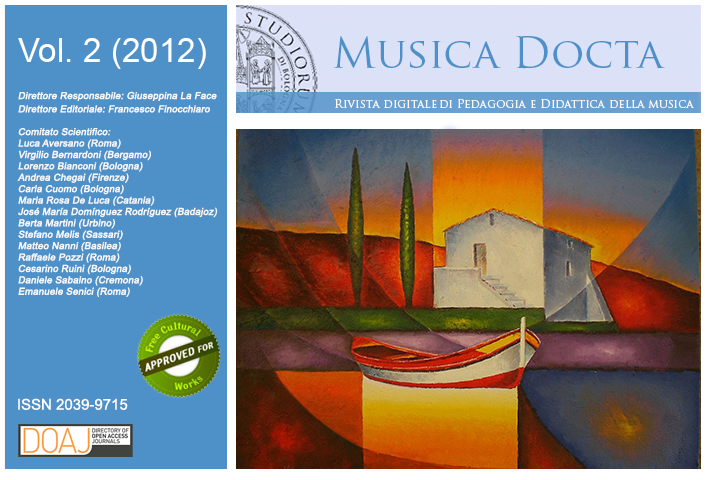Pierrot, poeta "ebbro di luna"
DOI:
https://doi.org/10.6092/issn.2039-9715/3228Keywords:
Schönberg, Pierrot lunaire, Sprechgesang, tonalità, atonalità,Abstract
Arnold Schönberg compose il Pierrot lunaire nel 1912 a Berlino, per la cantate di cabaret Albertine Zehme. L’opera consiste in un ciclo di ventuno melologhi, su testi del poeta simbolista belga Albert Giraud, tradotti in tedesco da Otto Erich Hartleben, per voce recitante (in Sprechgesang, ossia ‘canto parlato’) e ensemble strumentale (pianoforte, clarinetto in la o clarinetto basso in si bemolle, flauto o ottavino, violino o viola, violoncello, variamente combinati a seconda dei brani). Il Pierrot lunaire è una delle composizioni più rappresentative della fase cosiddetta “atonale” di Schönberg, caratterizzata appunto dalla rinuncia da parte del compositore all’impiego del linguaggio armonico tonale. Il percorso, rivolto a studenti della Scuola Secondaria di I grado, si basa in generale sull’intero ciclo per poi soffermarsi sul primo brano, Mondestrunken (Ebbro di luna), al fine di analizzare più in dettaglio alcuni aspetti della scrittura compositiva dell’autore.
Arnold Schönberg composed Pierrot Lunaire in 1912 in Berlin, for the cabaret singer Albertine Zehme. The work consists of a series of twentyone melologues, on texts by the Belgian symbolist poet Albert Giraud, translated into German by Otto Erich Hartleben, for narrator (Sprechgesang, or 'spoken song') and instrumental ensemble (piano, clarinet in A or bass clarinet in B flat, flute or piccolo, violin or viola, cello, in various combinations depending on the songs). Pierrot Lunaire is one of the most representative compositions of the so-told "atonal" phase of Schönberg’s work, characterized by his abandon of tonal harmonic language. The didactic-course, aimed at students of the lower secondary school, is generally based on the entire cycle and then focuses on the first piece, Mondestrunken (Moondrunk), in order to analyse in more detail a few aspects of the Author’s musical writing.
Downloads
Published
How to Cite
Issue
Section
License
Copyright (c) 2012 Anna Scalfaro
The copyrights of all the texts on this journal belong to the respective authors without restrictions.
This journal is licensed under a Creative Commons Attribution Share-Alike 4.0 International License (full legal code).
See also our Open Access Policy.
Metadata
All the metadata of the published material is released in the public domain and may be used by anyone free of charge. This includes references.
Metadata — including references — may be re-used in any medium without prior permission for both not-for-profit and for-profit purposes. We kindly ask users to provide a link to the original metadata record.






